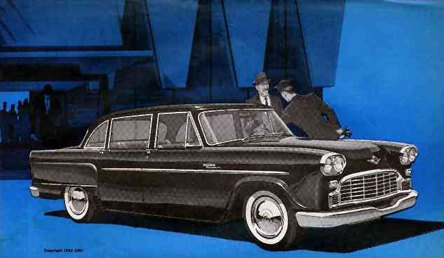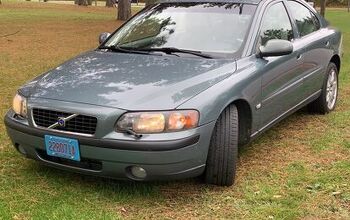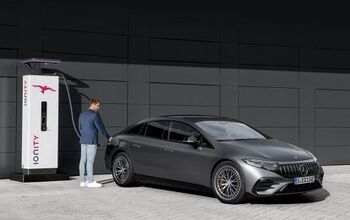Fleet Sales Rx: Checker Redux?
When Ford threatened to pull the plug on its Panther platformed rear wheel-drive cars, the livery and taxicab companies howled in protest and Ford backed down. Ford’s ancient leviathans are welded to the new car lot, but they’re a carriage trade mainstay; there’s no cost-comparable replacement. While rental fleets favor smaller econoboxes and mediocre midsizers, taxis, liveries and police departments still favor big, basic, practical, roomy, reliable, robust, rear-wheel drive automobiles. Sounds like it’s the perfect time to resurrect the Checker Marathon.
In the early 1900’s, America’s taxi business was booming. The demand for cars was so high that Checker Taxi of Chicago contracted with Commonwealth Motor Company to assemble taxicabs using bodies built by Markin Auto Body Corporation. The companies merged at the end of 1921. The Checker Cab Manufacturing Company was established in 1922.
By early 1923, Checker Cabs expanded its sales to New York City. In response to increased production demands (including sales to private buyers), the company relocated its assembly line to Kalamazoo, Michigan. Although the “Checker cab’s” driving dynamics were Paleolithic, the company’s vehicles were famous for their staggering durability and marvelous packaging. The design changed infrequently, which guaranteed consumer recognition and reduced maintenance and repair costs.
In the late ‘50’s, as personal car ownership increased, the demand for taxi and other livery vehicles decreased. In 1961, to offset the decline in taxi company orders, Checker entered the consumer vehicle market. Although the Superba (a Checker taxi with more chrome and a nicer interior) was not a big hit, it helped keep the company afloat. In 1962, the Marathon replaced the Superba Special. In 1963, it became the company’s only commercial model.
The Marathon remained virtually unchanged for the rest of its production run, save for a gradual switch to Chevy drivetrain components. Checker’s limited marketing campaign touted the car’s unchanging style and focused on durability, promoting it as a 200K-car. Meanwhile, taxi companies continued to be Checker’s largest market.
The 1970’s saw Checker sputter to halt. While its vehicles were still a paragon of durability, they weighed two tons and averaged fifteen miles per gallon. Soaring gas prices, double digit inflation, increasing costs, demand for fuel-efficient vehicles and the increasing reliability of Big Three iron made the purpose-built taxi an expensive proposition. Cab companies began converting conventional cars into taxis. Checker’s fate was sealed. The last new Checker rolled off the assembly line in 1982.
Since then, no U.S. based manufacturer has stepped up to the plate with a line of vehicles specifically built for fleet use. With today’s reduced design, development and production costs (including platform sharing and flexible manufacturing), and plenty of component-related talent for hire, perhaps it’s time to resurrect the concept of a Checker Marathon-style vehicle.
If nothing else, such a vehicle could help limit the depreciation mainstream models experience when their rental fleets dump their inventory on the used car market. In fact, this “new Checker” could be parts-bin engineered by any of the domestic nameplates. There should be four models available for fleet discounts.
First up: a front wheel-drive midsize driving appliance for the rental car and company car fleets. It would have a distinctive body shape and one basic configuration, with limited color choices and optional satellite radio and nav system for those willing to pay a bit more at the rental counter.
The other three models would be variations of the same full size rear-wheel drive car. The basic model would be a no-frills machine with a tight turning circle, hose-out interior, V6 engine and optional diesel. The package would maximize interior space; no need for high speed aerodynamic efficiency here (e.g. London’s Metro Cab and TX4). The base model would provide a basis for a blingified luxury-oriented vehicle with a V8, all the amenities and a cushy ride for the livery car and limousine/hearse conversion industries.
Finally, there would be the law enforcement model combining the taxi platform’s robust underpinnings with a hopped-up V8 from the luxury variant and improved aerodynamics, suspension, brakes, and steering for the inevitable high-speed chases. The interior would be specifically designed to accommodate the various gear that has overtaken modern cop cars. It could even have a standard telematic system used to track the car and provide instant communications and diagnostics back to the station (think On-Star on steroids).
There wouldn’t be any annual model changes, only running changes to keep up with the latest federal and state safety and environmental regulations. Prices would be based on volume sales, not individual units.
None of these fleet-oriented vehicles would be offered directly to the public. Eventually, they’d turn up in the used car market. But if they’re not worth much as used cars, so be it. There’s always someone out there looking for the cheapest transportation possible. It might as well be something built specifically for the job.
[RF interviews Checker Taxi Stand maven Matt Fry below.]
More by Frank Williams
Latest Car Reviews
Read moreLatest Product Reviews
Read moreRecent Comments
- Bkojote Allright, actual person who knows trucks here, the article gets it a bit wrong.First off, the Maverick is not at all comparable to a Tacoma just because they're both Hybrids. Or lemme be blunt, the butch-est non-hybrid Maverick Tremor is suitable for 2/10 difficulty trails, a Trailhunter is for about 5/10 or maybe 6/10, just about the upper end of any stock vehicle you're buying from the factory. Aside from a Sasquatch Bronco or Rubicon Jeep Wrangler you're looking at something you're towing back if you want more capability (or perhaps something you /wish/ you were towing back.)Now, where the real world difference should play out is on the trail, where a lot of low speed crawling usually saps efficiency, especially when loaded to the gills. Real world MPG from a 4Runner is about 12-13mpg, So if this loaded-with-overlander-catalog Trailhunter is still pulling in the 20's - or even 18-19, that's a massive improvement.
- Lou_BC "That’s expensive for a midsize pickup" All of the "offroad" midsize trucks fall in that 65k USD range. The ZR2 is probably the cheapest ( without Bison option).
- Lou_BC There are a few in my town. They come out on sunny days. I'd rather spend $29k on a square body Chevy
- Lou_BC I had a 2010 Ford F150 and 2010 Toyota Sienna. The F150 went through 3 sets of brakes and Sienna 2 sets. Similar mileage and 10 year span.4 sets tires on F150. Truck needed a set of rear shocks and front axle seals. The solenoid in the T-case was replaced under warranty. I replaced a "blend door motor" on heater. Sienna needed a water pump and heater blower both on warranty. One TSB then recall on spare tire cable. Has a limp mode due to an engine sensor failure. At 11 years old I had to replace clutch pack in rear diff F150. My ZR2 diesel at 55,000 km. Needs new tires. Duratrac's worn and chewed up. Needed front end alignment (1st time ever on any truck I've owned).Rear brakes worn out. Left pads were to metal. Chevy rear brakes don't like offroad. Weird "inside out" dents in a few spots rear fenders. Typically GM can't really build an offroad truck issue. They won't warranty. Has fender-well liners. Tore off one rear shock protector. Was cheaper to order from GM warehouse through parts supplier than through Chevy dealer. Lots of squeaks and rattles. Infotainment has crashed a few times. Seat heater modual was on recall. One of those post sale retrofit.Local dealer is horrific. If my son can't service or repair it, I'll drive 120 km to the next town. 1st and last Chevy. Love the drivetrain and suspension. Fit and finish mediocre. Dealer sucks.
- MaintenanceCosts You expect everything on Amazon and eBay to be fake, but it's a shame to see fake stuff on Summit Racing. Glad they pulled it.





































Comments
Join the conversation
As a longtime driver of a 95 CV copcar and a 2002 LX Sport I gotta tell you - I think that these are some of the better domestics out there. Don't laugh. My criteria: Drivetrain is about a bullet-proof as you will find, they are easy to work on and parts don't have to be ordered with a 3 week timeframe. Both of mine average 20-23 mpg overall city/hiway - with the stiffer suspension and a decent set of shocks/tires they ride and handle reasonably well. With a Marauder airbox/MAF and aftermarket tune, they are a lot quicker than you might think. They have probably been some of the most economical and dependable vehicles I've ever owned. I'm not geriatric aged and we own a variety of US, Japanese, and German cars. For my daily driving, I'll take my CV's any day thank you. Before you sneer at the "old" technology and platform think about WHY so many of these bulldozers are still out there. Maybe because they continue to function day in and day out as originally intended.